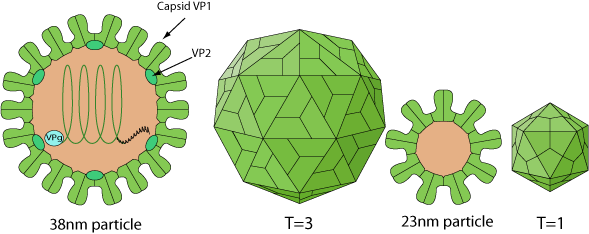Caliciviridae (taxid:11974)
VIRION

Non-enveloped, capsid of about 27-40 nm in diameter, with T=3 icosahedral symmetry. The capsid is composed of 180 capsid proteins.
GENOME
Monopartite, linear ssRNA(+) genome of 7.3 to 8.3 kb. The 5'-terminus is linked to a VPg protein and the 3'-terminus has a poly(A) tract.
GENE EXPRESSION
The virion RNA is infectious and serves as both the genome and viral messenger RNA. The genome encodes a polyprotein (ORF1). One or two smaller ORFs are expressed from a subgenomic RNA.
Cleavage of ORF1 polyprotein by the virus-encoded 3C-like cysteine proteinase yields the mature nonstructural proteins. The 3'-end terminal ORF encodes a basic protein (and the capsid protein) and is expressed through RNA termination-reinitiation.
Some Norovirus expressan alternative ORF by leaky scanning
Vesiviruses are apparently unique among the Caliciviridae in that the ORF2 encodes a capsid precursor protein that is proteolytically processed by the viral proteinase to yield the mature capsid protein.
ENZYMES
- RNA-dependent RNA polymerase [RdRp Q83883]
- VPG-type capping [VPg Q83883]
- NTPase-helicase [NTPase Q83883]
- Polyprotein major protease (Peptidase C37) [3CLpro Q83883]
REPLICATION
CYTOPLASMIC
- Attachement to host receptors mediates endocytosis of the virus into the host cell.
- Uncoating, and release of the viral genomic RNA into the cytoplasm.
- VPg is removed from the viral RNA, which is then translated into a processed ORF1 polyprotein to yield the replication proteins.
- Replication occurs in viral factories. A dsRNA genome is synthesized from the genomic ssRNA(+).
- The dsRNA genome is transcribed/replicated thereby providing viral mRNAs/new ssRNA(+) genomes.
- Subgenomic RNA translation gives rise to the capsid protein and VP2.
- Assembly of new virus particles and release by cell lysis.
Host-virus interaction
Apoptosis modulation
Murine norovirus and rabbit hemorrhagic disease virus induce host cell apoptosis


 .
.
Host gene expression shutoff by virus
Noroviruses and Vesiviruses mediate host translation shutoff by cleaving PABP1
 .
.
Matching UniProtKB/Swiss-Prot entries
(all links/actions below point to uniprot.org website)60 entries grouped by protein
13 entries
Capsid protein VP1 (CP) (Capsid protein) (Coat protein)
24 entries
Genome polyprotein (p254)
1 entry
Virulence factor 1 (VF1)
20 entries
Minor capsid protein VP2
2 entries
Uncharacterized protein VP3
Atlantic salmon calicivirus taxid:1489836
| Protein | ModelArchive |
| Putative minor structural protein | ma-jd-viral-39815 |
Bat sapovirus TLC58/HK taxid:1185359
| Protein | ModelArchive |
| VP2 | ma-jd-viral-58991 |
Bovine calicivirus strain Kirklareli taxid:1812179
| Protein | ModelArchive |
| Minor capsid protein | ma-jd-viral-64752 |
Bovine enteric calicivirus Newbury agent-1 (isolate Bovine/UK/Newbury1/1976) taxid:331642
| Protein | ModelArchive |
| Protein VP2 (Minor capsid VP2) | ma-jd-viral-64753 |
Calicivirus isolate TCG taxid:243550
| Protein | ModelArchive |
| VP2 minor capsid protein | ma-jd-viral-64751 |
Calicivirus pig/AB90/CAN taxid:520973
| Protein | ModelArchive |
| VP2 | ma-jd-viral-60846 |
Chicken calicivirus taxid:1172196
| Protein | ModelArchive |
| VP2 | ma-jd-viral-57104 |
Goose calicivirus taxid:1493858
| Protein | ModelArchive |
| Small basic protein | ma-jd-viral-66524 |
Mink calicivirus taxid:154122
| Protein | ModelArchive |
| Capsid protein (Coat protein) | ma-jd-viral-52280 |
| ORF3 protein | ma-jd-viral-46038 |
Norovirus GIII taxid:340017
| Protein | ModelArchive |
| Capsid | ma-jd-viral-54537 |
| VP2 | ma-jd-viral-36156 |
Rabbit calicivirus Australia 1 MIC-07 taxid:576948
| Protein | ModelArchive |
| Minor structural protein | ma-jd-viral-67207 |
Rabbit vesivirus taxid:303317
| Protein | ModelArchive |
| Capsid protein (Coat protein) | ma-jd-viral-52281 |
| Protein VP2 (Minor capsid protein) | ma-jd-viral-31373 |
Sapovirus (strain GII/Human/Japan/Sakai C12/2001) taxid:290314
| Protein | ModelArchive |
| ORF2 protein | ma-jd-viral-40101 |
Vesivirus ferret badger/JX12/China/2012 taxid:1615583
| Protein | ModelArchive |
| Capsid protein (Coat protein) | ma-jd-viral-52283 |
| Protein VP2 (Minor capsid protein) | ma-jd-viral-31374 |
Walrus calicivirus (isolate Walrus/Russia/7420/1977) taxid:146073
| Protein | ModelArchive |
| Capsid protein (Coat protein) | ma-jd-viral-52278 |
| Protein VP2 (Minor capsid protein) | ma-jd-viral-31372 |
